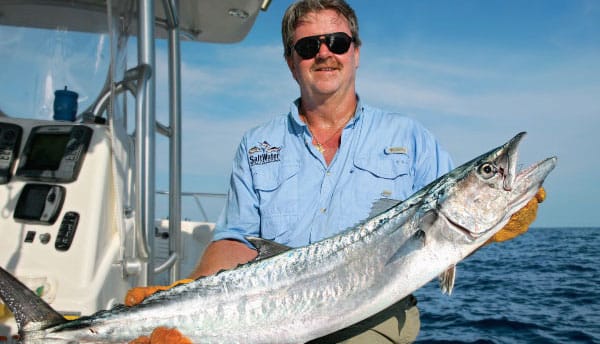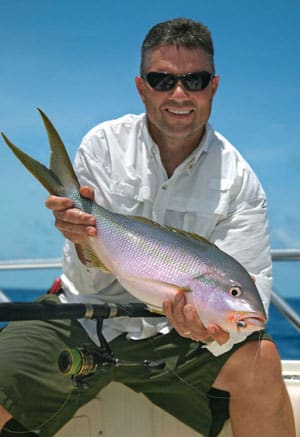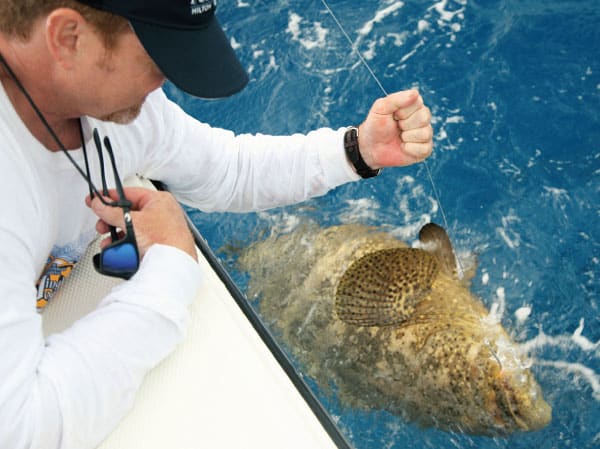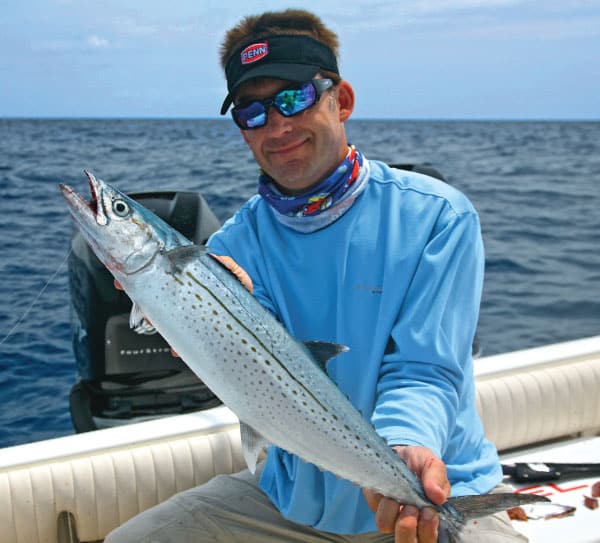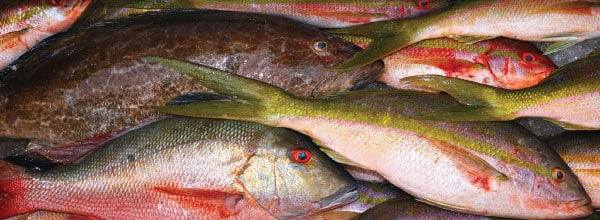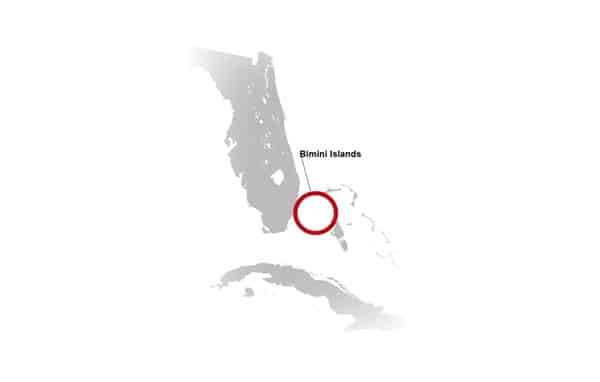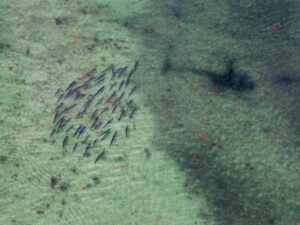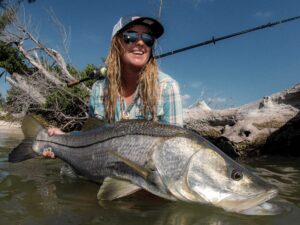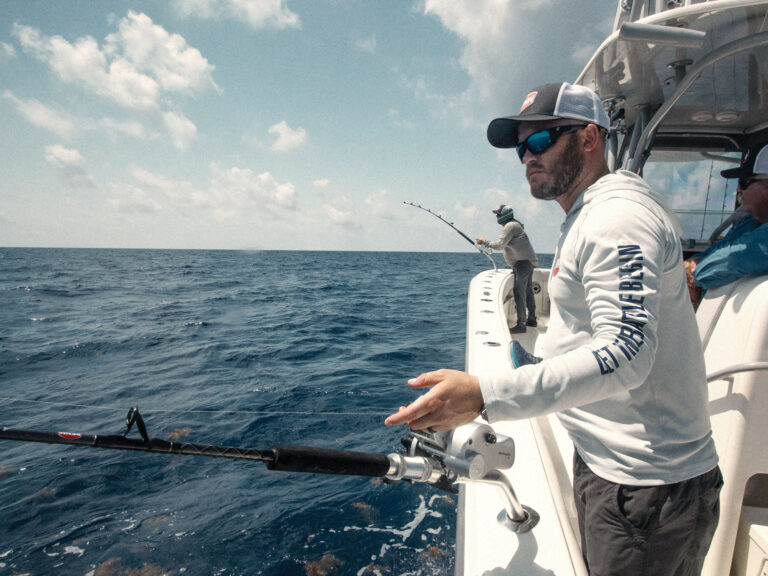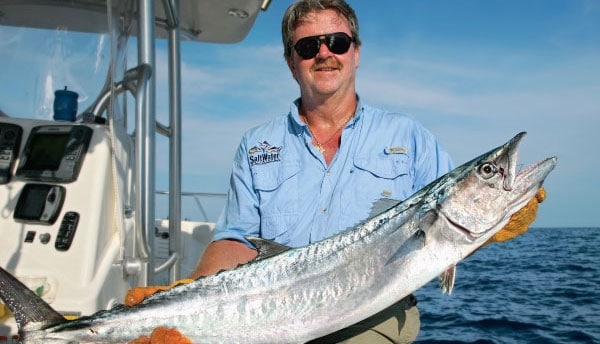
Bimini Fishing Main
Terry Flora had the hot hand. After bailing his share of big yellowtail snapper from a chum line, he wanted more of a challenge. Grabbing an outfit spooled with 30-pound braid, with a 50-pound fluorocarbon leader and 2-ounce circle-hook jig, he impaled a bonito strip on the jig and lowered it 70 feet to the reef.
He soon got what he was itching for: an all-out struggle to stop a big, powerful fish from breaking him off on the coral. He triumphed and landed a beautiful black grouper. As if that hadn’t earned him enough bragging rights aboard my MARC VI, he reloaded, dropped it back down and cranked up a big mutton snapper.
This is how it often goes off Bimini, in the Bahamas. Find the right piece of reef, dispatch a lot of chum and expand your game plan to include both bottomfish and pelagics. If you do just that, you’ll attract yellowtail, grouper, mutton snapper, cero and king mackerel, amberjack, horse-eye jack and — sooner or later — sharks.
Yes, the Bimini reefs are alive and often on fire.
‘Tail Chasing
The best way to cash in on a variety of reef species is to concentrate first on yellowtails. Once the ’tails are swarming in the chum slick, they’ll eventually lure in big grouper, amberjack, horse-eye jack, king mackerel and other predators looking to ambush them near the surface, where they’re easy prey. And the quality of the yellowtail snapper fishing around Bimini ranges from good to exceptional; just look for large reef areas with enough relief to sustain concentrations of these fish.
After locating solid reef structure, I anchor in 60 to 80 feet of water and deploy the chum bag. At once, reef and tropical fish — Bermuda chub, triggerfish, blue runner, ballyhoo and occasionally speedos — will rise for the tidbits. As long as there’s clean blue water and current, the ’tails will also appear. Whereas it’s hard to get a Florida Keys yellowtail to bite with 15-pound-test leader, you’ll catch a bunch of Bimini ’tails even on 20-pound-test. That’s because they’re not pressured as much here. However, if you’re looking for “flag yellowtails” around Bimini, you’ll need to gear up accordingly. Keeping the leader light and hook tiny will fool more big snapper. As for bait, a tiny piece of bonito or dolphin belly, slightly larger than the chum particles, is like candy. Pieces of ballyhoo and silversides would be my second choice.
Let the bait drift back at the same rate as the chum. Shake the chum bag, drop over a bait, and strip until it gets picked off by a ’tail. When the current is swift, adding a split shot helps the drift. Once hooked up, reel straight and fast to keep the fish from reaching bottom or being eaten by a grouper. Don’t pump and wind: That makes the ’tail look injured and vulnerable to predators.
Big Bound Fellas
Often I’ll play around with the ’tails for an hour or so before dropping down for a big grouper. When the water is clear, big black grouper can be seen traversing the reefs under the boat, blitzing the yellowtails. The problem is keeping these brutes out of the reefs. Our “exterminate grouper” setup consists of a Penn 6/0 reel spooled with 100-pound braid and rigged with a sliding egg sinker, followed by a barrel swivel, 10 feet of 100-pound-test fluorocarbon leader and a 9/0 extra-strong hook. It’s paired with a 130-pound-class stand-up rod.
We’ll find the bravest soul on the boat, strap a rod belt onto him, impale a live yellowtail on the hook and lower it to bottom. Once it’s there, the angler takes a few cranks on the reel and holds the rod parallel to the water. The panicking of the ’tail will be felt, followed by a big thump; the rod tip will then dive
toward the surface. At this stage, the angler leans back and cranks, pumping against a nearly locked-down drag. If the grouper isn’t kept off balance and heading up, it’ll make a break for the reef. We’ve taken grouper to 58 pounds around the Bimini reefs.
If monster fishing is not your game, smaller conventional outfits packed with 30- or 50-pound braid with 30- or 50-pound fluoro leaders, or even 20-pound spin tackle, provide a lot of fun. Use an in-line circle hook (7/0 to 9/0 size, based on baits) and just enough egg sinker to reach bottom. Knocker rigs (the sinker rests on top of the hook eye) work well, as does positioning the sinker above a swivel on the braided line with an 8- to 12-foot leader; the latter is especially effective on mutton snapper. Circle-hook jigs tipped with bait work as well.
Live pilchards caught around the islands, ballyhoo gold-hooked from the chum slick, freshly thawed Spanish sardines, squid, bonito chunks, ballyhoo plugs and sections of goggle-eyes will all see action when lowered onto the reefs. Everything from mutton snapper to grouper eat these. Live baits also entice horse-eye jacks, amberjack and ’cudas.
Pelagics Gone Mad
Reef-fishing around Bimini is a three-tiered effort: Work the surface for yellowtails, the bottom for grouper and mutton snapper, and near the surface for kings and cero mackerel. The king mackerel around Bimini can be huge.
For these, we use a large 20-pound-class spinner filled with monofilament or a small conventional outfit filled with 50-pound braid and a 100-yard top shot of 30-pound mono. I tie on an in-line circle-hook stinger rig (both hooks are circles) fabricated from 38-pound-test single-strand wire, placing the lead circle hook in front of the dorsal fin of a live yellowtail, blue runner or small cero mackerel and letting the stinger hook dangle freely. About 10 to 15 feet above the leader, I tie on a balloon float, then I free-line this rig well back in the chum slick, where it won’t interfere with the yellowtail fishing.
That live bait generally doesn’t last long. The circle hooks set themselves, and once line is screaming off the reel, it’s time for someone to grab the rod and fight the fish. We’ve taken kings up to 57 pounds with this tactic.
For sheer light-tackle fun, keep some 8-pound spinning tackle handy, rigged with 30- to 40-pound fluoro leaders and an in-line circle hook with live pilchards or ballyhoo, or 11⁄16- to 1-ounce jigs, such as the Williamson Gyro. When the ceros show up, toss them the live baits or pitch the jigs, and work them back fast. You’ll frequently get cut off, but you’ll draw strikes you wouldn’t have with wire leaders. You’ll have to gamble some terminal gear, but ceros run big here, into the double digits.
The Bimini reefs are productive, and even seasoned veterans will put down the rod and take a breather. As long as your chum is free-flowing, the fish aren’t going anywhere. And how many places can you wear down your crew catching quality fish, like we always seem to do around Bimini?
